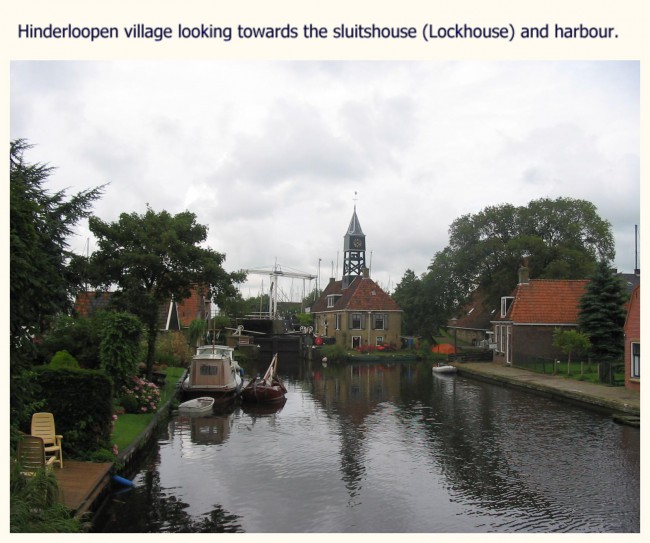
Unless you are lucky enough to sail directly into the harbour, it may take several hours and more than a few changes of trains to reach the tiny Dutch village of Hindeloopen in the Northern Netherland’s province of Friesland.

I alighted at the deserted railway station and felt a stab of disappointment as the town of Hindeloopen, itself, is not immediately visible from the railway station. To add to that, the only residents assigned to “meet and greet” tourists are some rather indulgent-looking cows! Not what I was expecting, at all.
After a twenty-minute walk carrying luggage with no wheels, (remember those times?), I reached the village of Hindeloopen proper and began a step back in time to the 16th Century, where Hanseatic traders plied cobblestone streets and canals; where ol’ salty Sea Captains built iconic homes with gabled facades and decorated their interiors with elaborate folk art motifs, peculiar to the area.

History of Hindeloopen and Hindelooper Folk Art, Friesland
Ever since the 13th Century, the moorings in the harbour at Hindeloopen provided Norwegian and other Hanseatic traders with a safe haven from the rough weather in the ZuiderZee. All these foreign influences were gradually absorbed into village culture in Hindeloopen. Even the language spoken in the village has more in common with dialects from the Scandinavian countries than it has with its own national Dutch language.
At an altitude of 1 metre below sea level, the village of Hindeloopen had often suffered economic setbacks from devastating floods and inundation from sea water until 1932 when the Afsluitdijk was constructed and the rough seas of the ZuiderZee were tamed at last.
Unfortunately, the closure of the Zuiderzee to the open sea also meant the rapid demise of maritime trade and this forced the citizens to search for an alternate means of income. The unemployed sailors soon discovered there was a market for the traditional wooden objects they’d painted during the times when the weather prevented them from going out to sea. The painted objects became known as Hindeloopen art.

Today, the visitor to Hindeloopen will see grassy dykes along the ZuiderZee, dotted with grazing sheep; a harbour bustling with tourists and luxury yachts and many colourful rowboats in Hindeloopen’s sleepy canals. In summer, the many gardens burst with lush hydrangea blooms and the various artists open their studios to showcase an amazing collection of painted wares.
Art Studios in Hindeloopen
Traditionally, the men of the village are the painters of Hindelooper folk art; the woman and wives merely operate the shopfront where the art is sold, so any questions I had on the technical aspects of painting during my visit went largely unanswered. On reflection, I thought this barrier might inadvertently protect the cottage industry from contemporary artistic influences and maintain its purist form.
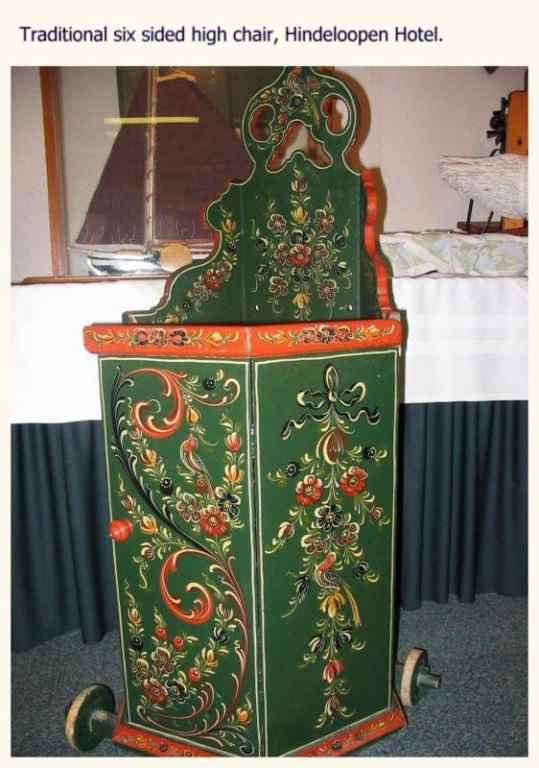
At the village’s only hotel, I found examples of Hindelooper folk art including a Spinning wheel, a six-sided High Chair and a Bridal suite complete with a “box-bed,” built into the wall. Furthermore, whilst dining at the nearby Pancake cafe, I noticed every chair and table, therein, was painted in Hindelooper florals by Gauke Bootsma, whose neighbouring studio is brimming with a stunning array of art.
Gauke Bootsma
The sheer quantity of works in Bootsma’s shop is absolutely overwhelming. Although his work is in a contemporary light and airy style called, ‘Basic Hindelooper’, the larger items of furniture and serving trays are decorated with a detailed panel depicting village scenes such as sailing boats, Hindeloopen Sluitshouse, (Lock House), or typical Dutch windmills.
The shop’s display is themed around the traditional background colours of Hindelooper ie: one room has pieces on stained timber; another has monochromatic white and blue designs, and still another has designs on green backgrounds, a feast for the eyes.

Whilst browsing the many cabinets, wine racks, gate-leg tables, milk cans and smaller items in this shop, I spotted the artist, (who was once destined for a career in seafaring like his Harbourmaster father), hard at work upstairs in his studio, producing yet another beautiful Hindelooper item. On seeing me looking at him working, he quietly closed the door to his workshop. The artists can sometimes be secretive about their techniques!
Harmen Zweed
Directly opposite the town’s Hotel, is the studio of Harmen Zweed who paints in the Classic style. There is a ‘must see’ door lavishly decorated with biblical motifs, fruit, detailed flowers and scrolls, all painted with translucency and an illusion of depth not seen in the Basic style. The six-sided traditional high chair gives the visitor a hint of what the Zweed’s kitchen must be like, which is painted completely in Hindelooper.

According to Jenny, (the painter’s wife), who operates the Zweed shop, there are ten colours traditionally used in Hindelooper painting, with the predominant floral motifs being the Dogrose, Starflower and Carnation, but tulips may sometimes be used.
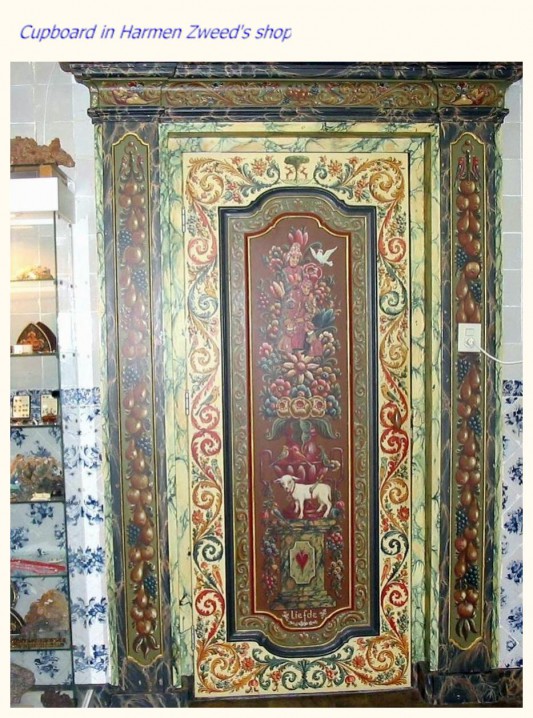
You will find several other painting studios in Hindeloopen such as Iekoon and Meine Visser’s shop. Het Roosje’s studio, established in 1894, is almost a museum in itself and contains expertly painted stair-stools for alcove wall-beds, furniture and specialist woodcarving.
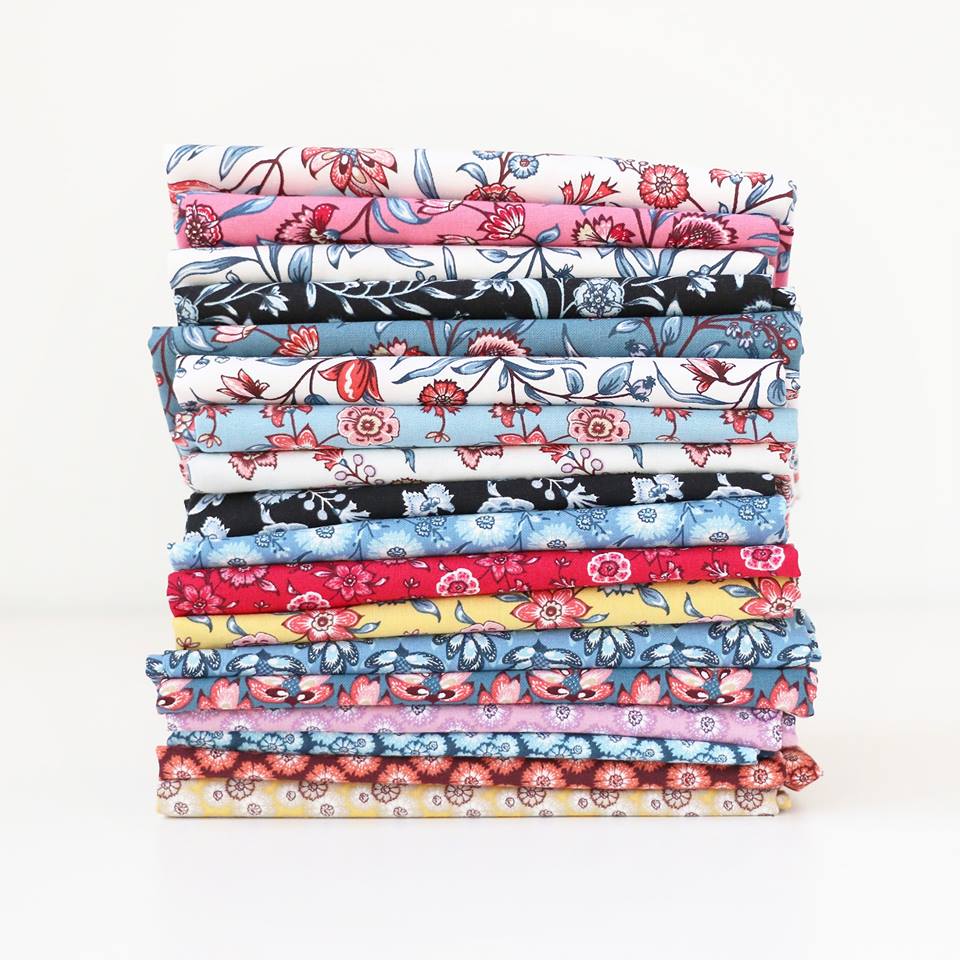
Harmen Glashower’s stunning painting is impressively detailed, but his shop is open only upon request, although I did find him working in the nearby Dutch Fabric shop. The shop stocks the traditional chintz fabrics used in the Hindeloopen folk costumes, and has a photographic catalogue of Glashower’s painted work available for browsing.

HISTORIC FOLK ART in MUSEUMS
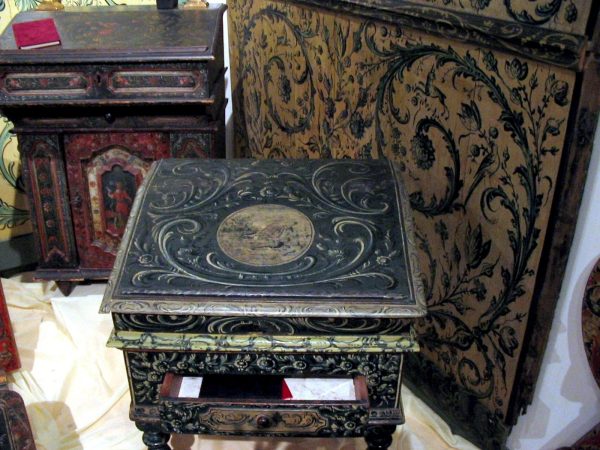
The Museum Hidde Nijland Foundation located in the Town Hall (circa 1683), is the place to view Hindeloopen’s painting heritage. Not only is there an enthralling collection of colourful tines, bowls, and cupboards, but also furniture and staircases for wall-beds, dating back to the 17th and 18th Centuries.

My personal favourite was a wall panel in blue on a white background, with bird and floral motifs. I noted a faux marble finish was often incorporated into the rim or side of an object. The display of traditional and brightly coloured folk costumes and Dutch tiles are inspirational in colour and design.
Would you like to know more about Traditional forms of art in Hindeloopen? Check out these links.
Glashouwer Hindeloopen – in Dutch



A wonderful post. I especially liked your comment that ‘On seeing me looking at him working, he quietly closed the door to his workshop.’
LikeLiked by 2 people
Why did that appeal to you, Peggy?
LikeLiked by 1 person
I just liked his subtle way of showing his desire for privacy.
LikeLiked by 1 person
Indeed!
LikeLiked by 1 person
Lovely pictures with vivid descriptions
LikeLiked by 2 people
Thanks for taking the time to make a lovely comment.
LikeLike
Amanda, many thanks for sharing this journey. It is such a quaint and inviting place. I want to eat pancakes and drink hot coffee on the veranda overlooking the canal. I also love brick streets in old towns. They give it a community-like feel. Keith
LikeLiked by 1 person
It really is an experience to go there, Keith. As it was pre-digital era, I don’t have the very best photos but I feel sure that they may be somewhere on the net.
LikeLiked by 1 person
Awesome photos from Netherlands 👌🌷🙏 so happy to view 👍🏻😍
LikeLiked by 2 people
Thank you. I travelled there some years ago but not much has changed.
LikeLiked by 1 person
You are welcome and thank you for sharing 🌷🙏♥️🌷
LikeLiked by 1 person
Those blue and white designs are just lovely!
LikeLike
It is a fairly easy art form to pick up yourself, Ang, if you were interested in learning it yourself.
LikeLiked by 1 person
Very cool!
LikeLiked by 1 person
Thank you, Martin!
LikeLike
What beautiful intricate designs! and what a fascinating story of the city and the people that live there. Glad they still take the time to make such incredible pieces!
LikeLiked by 1 person
I really appreciate your visit to this post and taking the time to comment. I had fun staying there even if the weather was inclement most of the time. It seems that when I visit Holland it often rains. Even so, we saw some marvellous sites and felt like we had really experienced a European village from centuries ago. It isn’t easy to get to Hindeloopen but these small villages reward you with many unique memories. Have you travelled much in Europe, Linda?
LikeLiked by 1 person
Certainly not as much as I’d like to. Have been to Portugal and the Andalucia region of Spain. Although when travelling we tend to stick to larger towns, the smaller ones certainly have a lot to offer the visitor like you’ve pointed out in your post 🙂 Certainly looking forward to travelling more in the future!
LikeLiked by 1 person
A good point, Linda. The larger cities attract many tourist who feel that they need to maximize their time in a foreign country by sticking to the main towns. I think forward planning a trip might be a way to see the unique things the villages offer without wasting too much of the precious holiday time. How did you find Portugal? It was a place I had on my priority list.
LikeLiked by 1 person
I loved Portugal! Spent two weeks travelling from Porto (fav city there…big but not on a grand scale…very walkable and lots of enjoyable areas), to the Algarve for a couple of nights, to Evora, then to Lisbon (which although has lots of sites was very busy and a lot bigger than I expected). We did it all by public transport which is fantastic there! If you search my site you will find some Portugal blogs. Definitely make plans to go there…it’s got lots of smaller villages too which if we had more time I would have loved to stay and explore more of. Happy planning 🙂
LikeLiked by 1 person
Great info, Linda. I can hear that you loved the region so I will look for those blog posts. Thanks so much. How was the temperature there? Not too hot?
LikeLiked by 1 person
We went the last two weeks in February and really lucked out with weather. It was fabulous right up until the last couple of days in Lisbon. The Algarve doesn’t really start to open up until after Easter so it was a bit quieter than usual, but we didn’t mind that at all. I’d say go in the spring or autumn to avoid the extreme heat and the crowds.
LikeLiked by 1 person
I will keep that in mind. Although we have the heat out here in Australia, I don’t like it at all….I was probably born in the wrong hemisphere. Lol.
LikeLiked by 1 person
I’d never heard of Hindeloopen Amanda – this is fascinating! And yes, I do remember luggage without wheels. When you think about how long ago wheels were invented, it seems astounding that it took so long for anyone to think of sticking some to a suitcase!!
LikeLiked by 1 person
The only people outside of the area who may have heard of Hindeloopen would be former residents or folks like me interested in the folk art. It has many links with Rosemaling which is what led me to seek out the village. The art is popular in Japan and various Japanese artists also travel there to study the old pieces.
You are right about the wheels! Considering we have had trolleys with wheels for centuries.
LikeLiked by 1 person
Yes,I can see the similarities to Rosemaling and it also seems to have something in common with the style of traditional narrow boat art here in England
LikeLiked by 1 person
Most folk art has elements or motifs that you might find recognizable. The Bauernmalerei in Germany, the Alpbachtal in Austria. It often eminated and developed from religious adornment and symbolism, such as the tulip flower – representing the trinity. So there are many similarities.
LikeLiked by 1 person
Oh that tray !! – the beautiful barques, or whatever they are ..
LikeLiked by 1 person
It is eye-catching – that is one reason I travelled there.
LikeLiked by 1 person
Have you noted that one of your followers has defended you against an M-R comment (is a blog an online journal ?) ? I explained that this is an ongoing game, but she probably doesn’t believe me. Nice that she took the trouble – nice for you ! [grin]
LikeLiked by 1 person
If you are talking about peNdantry, it is a he, not a she. And yes, I noticed and replied commented earlier this morning.
Nice for me, yes. Although one day I might take offence at your pet name for me…..
LikeLiked by 1 person
All I can say, wow amazing.
LikeLike
I am not at all surprised it caught your eye, Ineke!
LikeLiked by 1 person
There is more to The Netherlands than tulips or cheese.
My mother was from Friesland.
Nice post Amanda.
LikeLiked by 1 person
Thanks Gerard. That is a lovely compliment.
LikeLike
What wonderful memories. I love small villages that instantly remind you of their past history.
The chintz fabrics photo especially appealed to me. Nice colours and designs.
LikeLiked by 1 person
The Hindeloopen chintz designs are really out there as the old designers packed several prints and colours along with plain fabric, all together in their folk costumes. Yet they seem to have an uncanny ability to make them work so well together! It is amazing.
LikeLike
What an interesting place, and well worth a visit. Their artwork is exceptional!
LikeLiked by 1 person
It was so special and I feel so lucky being able to get there. I nearly didn’t make it as I didn’t realise I had to be in a certain part of the train to travel there.
The trains in Holland split off in different directions depending on whether it is the front or back carriages. I was lucky a passenger alerted me or I could have ended up goodness knows where!
LikeLiked by 1 person
That was lucky!
LikeLiked by 1 person
Amazing cupboard and fascinating journey.
LikeLiked by 1 person
Can you imagine having that cupboard in your house and looking at it everyday. I would never get anything done! Mesmerizing.
LikeLiked by 1 person
What a quaint village, so picturesque, reminds me of a Christmas village
LikeLiked by 1 person
It does look a little like a Xmas village. Perfect gardens and prim proper houses. No elves were seen though!
LikeLike
The detail on the objects in the museum plus on the exteriors of the buildings is charming and compelling. I’m glad you got to see Hindeloopen art in person. Thanks for sharing it here.
LikeLiked by 1 person
Europe has many hidden treasures tucked away in villages like this one that are absent in the “newer nations. I am glad that they preserve the past traditions so that we can enjoy them now.
LikeLiked by 1 person
Wow… What a talent !! I am totally impressed by seeing this artwork . Thanks for sharing 👍
LikeLiked by 2 people
It is eye-cathing Raksha. Thanks for taking the time to comment.
LikeLiked by 1 person
Beautiful photos so well captured with captions to describe. Never been to Netherlands but feel like going there now 🌻😊. Thank you for sharing 🥰.
LikeLiked by 1 person
How wonderful that I have inspired you to visit the Netherlands, Lyn and thanks so much for a sweet comment. Hindeloopen is not an easy place to get to, and there are the trains to work out, but there are many places in and around Friesland, well all of the Netherlands really to explore. I hope you are able to discover them!
LikeLiked by 1 person
Thank you Amanda for your tips 👍
LikeLiked by 1 person
You are welcome, Lyn.
LikeLiked by 1 person
I think I’d have a hard time walking a distance carrying a suitcase. Mine is old but it does have wheels…for now. You know how much I love that kind of art and would be all over it hoping I could afford to take some home with me. But where would I put it? I hope it is an art form that is never lost. Thanks for sharing this and inspiring us again..
LikeLike
Marlene, I thought I had answered your comment but it is not appearing here. If I answer on my phone sometimes the comment doesn’t get posted if I click off quickly on to something else. Internet in some parts here can be pretty slow…. (lack of government foresight but I won’t start on that). I can well understand you need wheeled suitcases! As to where you would put a treasure from Hindeloopen: You would use it, as most of the pieces are designed to be functional more than decorative. I have one small wooden container with lid that I keep my whole nutmeg in ( ready for grating in meals), another tray that I use daily for my morning tea and I am sure there is a third that I use in some fashion – oh yes, a foot stool!
LikeLiked by 1 person
I’m all for useful. 🙂 No worries about answering. Sometimes I forget I have commented somewhere. Well, most of the time I forget. 🙂
LikeLiked by 2 people
It happens to me too, Marlene. It comes with aging.
LikeLiked by 1 person
It must take an amazing amount of patience to produce each piece. I can appreciate the effort put in, marvel at the beauty, but wonder how such ornate pieces could be displayed in most of todays home. Yes, suitcases without wheels – I remember them well.
LikeLiked by 1 person
Astute point, Chris. Many home decor trends are so minimalist there isn’t a great deal of call for traditional art these days. Plus there is all those neutral colours and the traditional art always sought to liven up the home during a dark cold winter, so the artists used bright colours which doesn’t work with neutrals!
However, I think these objects were made to be functional, not decorative. So I do use mine. I just started using a tray I purchased from Bootsma’s shop in Hindeloopen and it stands up to daily use really well, so should last for years. That is actually what appeals to me about the traditional objects. They are incredibly functional as well as being pretty to look at.
LikeLiked by 1 person
This was great! Thanks for sharing this 💚
LikeLiked by 1 person
Glad you enjoyed reading about it
LikeLike
Beautiful artistic designs. Cannot be found these days. Thanks for sharing such piece of art.
LikeLiked by 1 person
They painted with such imagination in those days, Shauna. It is to be admired. I love to paint in this style myself. Have you seen these style before?
LikeLike